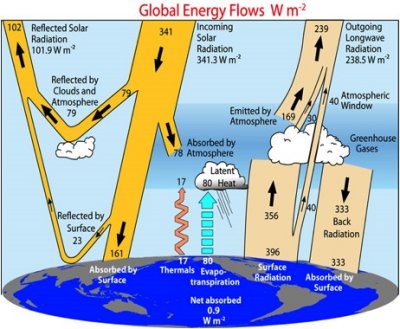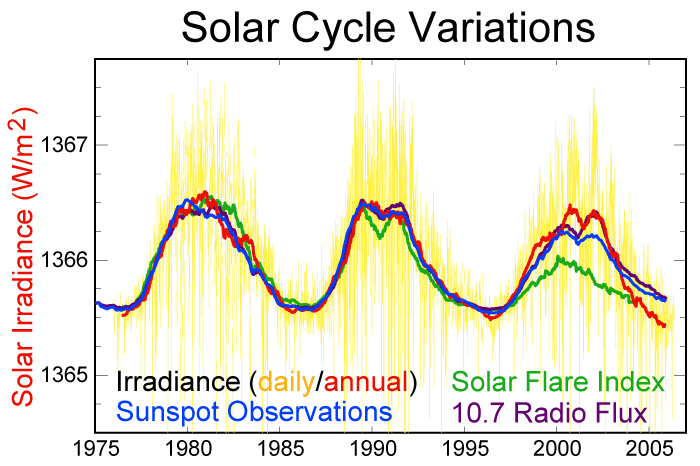Atmosphere and change
The atmospheric system
Input: incoming solar radiation (insolation)
Processes: atmospheric processes
Output: reflected solar radiation and outgoing long-wave radiation

Source: http://www.climate-service-center.de/030987/index_0030987.html.en
Changes in balance - solar radiation
Sunspots are regions on the solar surface that appear dark because they are cooler than the surrounding photosphere, typically by about 1500 K (thus, they are still at a temperature of about 4500 K, but this is cool compared to the rest of the photosphere). They are only dark in a relative sense; a sunspot removed from the bright background of the Sun would glow quite brightly.
Source: http://csep10.phys.utk.edu/astr162/lect/sun/sunspots.html

Source: https://en.wikipedia.org/wiki/Solar_cycle
Changes in balance - Albedo
Albedo means how reflective a surface is. If a surface has a high albedo then more of the sun's energy is reflected. Fresh snow has one of the world's highest albedos, reflecting up to 95% of the sun's energy. Darker surfaces like tarmac roads have a much lower albedo, only reflecting about 5% of the earth's energy.
Source:http://greenfieldgeography.wikispaces.com/Atmosphere+and+change

Source: http://climate.ncsu.edu/edu/k12/.albedo
Because snow and ice have relatively higher albedos it is important that we try and protect them. If snow or ice melts and is replaced by rock or dark vegetation then more of the earth's energy will be absorbed rather than reflected. These changes in the energy balance will cause even more warming and probably more melting creating a spiral of melting and warming. Not only is the melting of ice is bad, but also the polluting or dirtying of it is too. If snow gets dirty then it is darker and more likely to absorb rather than reflect.


Source: http://greenfieldgeography.wikispaces.com/Atmosphere+and+change
the global distribution of historical land cover conversions, primarily to croplands (CRO) and (b) the associated changes in surface albedo

Source: http://www.clarku.edu/article/nasa-funded-climate-change-study-focus-meeting-clark
Changes in balance - long-wave radiation

http://disc.sci.gsfc.nasa.gov/giovanni/additional/users-manual/DICCE_Help
The greenhouse effect

Source: http://www.washington.edu/news/2014/11/10/global-warming-not-just-a-blanket-in-the-long-run-its-more-like-tanning-oil/
Climate change - enhanced greenhouse effect

Source: https://www.weadapt.org/knowledge-base/climate-adaptation-training/adapting-to-a-changing-climate-guide-to-local-early-action-planning-leap-and-management-planning
Source: https://www3.epa.gov/climatechange/science/causes.html

Source: http://scienceblogs.com/significantfigures/index.php/2013/04/02/three-iconic-graphs-showing-the-climate-fix-were-in/
Consequences of global warming
Rising Sea Levels: This is probably the best known impact of global warming, Rising sea levels itself will cause many impacts like loss of land, climate refugees and changes in ecosystems. Most of the related problems are looked at individually below.
Coastal Flooding (cost of defences): Protecting coastlines is an expensive business and one that needs continually to re-assessed. The sea is a powerful force and can destroy or breach even the strongest defences. In addition as sea levels rise, some defences become too small, it is believed that the Thames Flood Barrier designed to protect London will have to be enlarged in the future at enormous cost.
Climate Refugees: As sea levels rise more and more people who live on the coast will lose their homes and have to be relocated. Some richer countries might be able to protect their populations, but low lying countries like the Maldives and poor countries like Bangladesh will see a rapid increase in climate refugees.
Loss of Biodiversity: As temperatures warm and sea levels rise, the habitats of many plants and animals will alter. Although some animals may be able to migrate to new areas, other plants and animals will lose their habitats forever and become extinct. The most talked about is probably the polar bear, but coral reefs will see some of the biggest changes and losses of biodiversity.
Changes in the Gulf Stream: Much of NW Europe is currently warmer than areas at similar latitude. The reason that the NW of Europe (and in particular the UK) is warmer is because of the Gulf Stream (or conveyor belt) which moves warm water from the Gulf of Mexico to Europe. This warm water warms NW Europe and protects it from cold winters. However, one of the less well-known impacts of climate change is a mini ice age in NW Europe. The Gulf Stream works because just south of Iceland the warm water sinks and returns south. The reason the Gulf Stream sinks is because of the salinity (density) of the water. Permafrost melting in Northern Russia and ice shelf melting on Greenland is changing the salinity of the water in the area. Scientists believe that the salinity of the water might fall so much that the warm water stops sinking and therefore stops the Gulf Stream. If this happens then NW Europe will begin to cool as it stops receiving the warm waters of the Gulf Stream.
Desertification: Rising temperatures and reduced rainfall will mean that some areas of the world will see increased rates of desertification. Although much of the world's desertification is caused by human factors reduced rainfall and warmer temperatures will mean that some vegetation will find it harder to survive.
Loss of Industry: Coastal industries like tourism and fishing will be effected as sea level rise and destroy holiday resorts (or even whole islands) and engulf fishing ports and communities.
Flash Floods: Rising temperatures will not mean that everywhere gets drier and warmer. It might mean some places get cooler and it will certainly mean some place get wetter. Melting ice sheets, permafrost and glaciers will mean more water is released from its storage. Rising temperatures will in turn mean more water is evaporated into the atmosphere. The atmosphere can only hold so much water before it becomes saturated and rains. Because of the amount of evaporation rainfall (especially convectional) will become more intense and cause more flash floods.
Increased Tropical Storms: Some scientists believe that warming temperatures are increasing the magnitude and frequency of tropical storms. Tropical storms receive their energy from the sea. For a tropical storm to develop and strengthen it needs warm seas so with global warming causing sea temperatures to rise it might be increasing the number of tropical storms.
Heatwaves and Forest Fires: Increasing temperatures will cause heatwaves in an increasing number of countries, including countries that are not prepared for the heat e.g. France where an estimated 14,800 died in the 2003 heat wave. Also Hot temperatures can dry out vegetation and increase the risk of forest fires (both natural and man made).
Melting Permafrost: Permafrost is ground that contains permanently frozen water. As global temperatures rise permafrost can begin to melt. The melting permafrost not only releases large amounts of methane in the atmosphere increasing the greenhouse effect, but also releases freshwater into the seas which may affect some of its ocean currents.
Droughts and Famines (crop failure): As global temperatures rise some areas of the planet will become more arid (drier). As areas become more arid there will be increasing water shortages and crop failures leading to drought and famine. Areas that will be badly affected include the Sahel (the area south of the Sahara Desert), where growing populations are putting ever increasing pressure on existing resources.
Skin Cancer (diseases): Exposure to the sun's UV rays can cause increases in skin cancers and other diseases like eye cataracts. Areas that are particular badly hit are countries like Australia that have also seen damage to the Ozone Layer.
Source: http://greenfieldgeography.wikispaces.com/Atmosphere+and+change

No comments:
Post a Comment